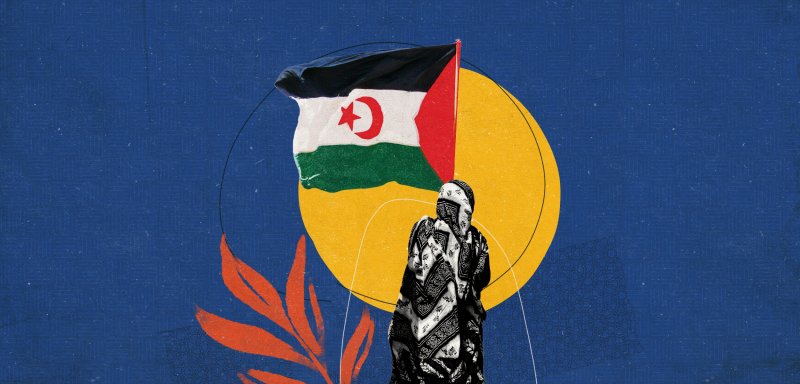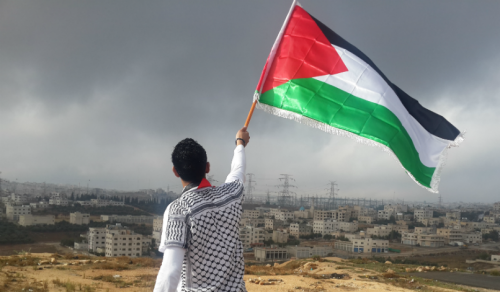In Algeria’s desert town of Tindouf, Sahrawi refugees gather around supply trucks each morning, unloading bricks and timber to rebuild homes devastated by last September’s floods.
Mohammed Hallab, 44, is one of the many refugees residing in the vast camps that scatter the region. The memories of the disasters that affected him are still on his mind.
"Everyone was on edge, especially with the constant updates and weather warnings that kept coming in," he recalls. "It felt like the storm was never far away."
On January 15, the Sahrawi Red Crescent began distributing construction materials to assist families in rebuilding after torrential rains ravaged the mud-brick shelters of thousands, further worsening the already dire conditions of this long-standing displacement.
“The torrential rains of last September caused significant damage in the Dakhla camp,” said Yahia Bouhbini, president of the Sahrawi Red Crescent. “Some 538 families saw their homes affected, with 30% completely destroyed. Schools, childcare centers, the camp’s only hospital, and several administrative facilities were also heavily damaged.”
Bouhbini also expressed growing concern over the limited emergency supplies available to meet the needs of the displaced population.
“With the potential for another severe rainfall in 2025, the situation remains precarious,” he added.
Rainfall in this part of the Sahara is a rare occurrence, typically happening once every decade. Significant rains have been recorded in 1985, 1995, 2006, 2015, and most recently in September 2024. When rain does fall, however, the impact is often devastating.
"This is not the first time floods have hit the region," says Hallab. "I was personally affected in 2006, when I was newly displaced, and a second time in 2015, when I was married, and my wife was in her second month of pregnancy. At every flood, we, along with all the residents of the camps, lost everything we had due to the relentless rainfall that lasted for 12 days."
The seasonal rains that began on September 19 brought intermittent downpours, with the heaviest rains occurring on the night of September 22–23. The fragile infrastructure of the camps, including mud-brick homes, was unable to withstand the overwhelming deluge.
In the immediate aftermath of the floods, the Sahrawi Red Crescent distributed tents and essential shelter materials to displaced refugees, according to Bouhbini. However, with its resources stretched thin, the organization has issued urgent calls for broader international humanitarian support to address the growing needs of affected families.
Rainfall in this part of the Sahara is a rare occurrence, typically happening once every decade. Significant rains have been recorded in 1985, 1995, 2006, 2015, and most recently in September 2024. When rain does fall, however, the impact is often devastating.
“These floods add another layer to the ongoing struggles of the Sahrawi refugees,” he explained.
The camps in Tindouf have been home to this community for nearly five decades, making it one of the world’s longest-standing refugee situations, second only to that of the Palestinians.
The origins of the Sahrawi refugee crisis trace back to the armed conflict between the Polisario Front and Morocco over Western Sahara, a territory that remains on the United Nations' list of non-self-governing regions. As the conflict escalated, thousands of Sahrawis fled violence and persecution, seeking refuge in five camps established in Algeria’s Tindouf province between 1975 and 1976. Throughout the decades, these camps have become home to generations of refugees, enduring a protracted exile with little hope for a resolution.
Life in Tindouf is marked by extreme hardship. Refugees live in makeshift shelters, often constructed from mud bricks or tarpaulins, which offer little protection against the region's frequent sandstorms and rare, yet devastating rains. Over 90% of Sahrawi refugees depend on humanitarian food aid, a reliance made even more precarious by the rising global cost of living and the mounting effects of climate change on local agriculture.
Today, three generations of Sahrawis continue to endure these harsh conditions, with overcrowded living spaces, poor infrastructure, and limited access to basic services like water and healthcare. Despite these challenges, they remain resilient, clinging to the hope of one day returning to their homeland.
The camps in Tindouf have been home to this community for nearly five decades, making it one of the world’s longest-standing refugee situations, second only to that of the Palestinians.
“The multiplication of global crises directly impacts Sahrawi refugees,” said Samir Zimouchi, a representative of the International Committee for the Development of Peoples, one of the NGOs working in the camps. He highlighted the shifting priorities of donor countries, noting that humanitarian agencies are increasingly struggling to meet the needs of the refugees.
“The war in Ukraine, for instance, has driven up food prices, forcing U.N. agencies to permanently cut assistance,” Zimouchi added. “Meanwhile, the Sahrawi crisis is largely ignored by international media.”
The harsh conditions in the Tindouf camps have pushed many, like Hamdi Ammar al-Toubali, to seek a better life elsewhere. al-Toubali, 40, left the camps for Europe but stresses that migration among Sahrawis is not driven by “opportunity but by necessity.”
"Life's hardships and the desire to support our community under the constraints of displacement are the real reasons behind leaving," he said. "Every Sahrawi who has migrated abroad is now supporting at least ten family members back in the camps."
Now a deputy representative of the Polisario Front in Scandinavia, al-Toubali notes the significant role the Sahrawi diaspora plays in advocating for their cause.
“Through activism, they have helped maintain global attention on the plight of Sahrawi refugees,” he added. “In cities across Europe, especially in Spain, France, and Belgium, Sahrawis continue to mobilize support, from demonstrations to political events.”
In Spain, Teslem Sidi, born in the Tindouf camps in 1994, made history in 2022 when she was elected to parliament after gaining Spanish citizenship. Following the September floods, Sidi and her parliamentary group, part of Spain's "Sumar" party, urged the Spanish government to provide immediate humanitarian assistance to the Sahrawi camps.
Life in Tindouf is marked by extreme hardship. Refugees live in makeshift shelters, often constructed from mud bricks or tarpaulins, which offer little protection against the region's frequent sandstorms and rare, yet devastating rains. Over 90% of Sahrawi refugees depend on humanitarian food aid, a reliance made even more precarious by the rising global cost of living and the mounting effects of climate change on local agriculture.
"I was born and raised in these refugee camps for 12 years," Sidi said, calling for relief. "The compounded suffering caused by the floods has only worsened their already dire situation."
Even in the face of adversity, some Sahrawis continue to flee Moroccan-controlled Western Sahara, seeking refuge in the camps of Tindouf, where their struggle for self-determination endures.
For Hallab, the journey to safety was fraught with danger and loss. Nearly two decades ago, Hallab fled his home in Western Sahara, evading Moroccan authorities who had targeted him for his political activism. He narrowly avoided arrest, retreating into the arid expanses of the Western Sahara desert.
"Eventually, in 2004, I crossed into the Sahrawi refugee camps, breaching the Moroccan wall of shame that divides Western Sahara and its people," he said. “Leaving behind my home, family, and friends was incredibly difficult, but for those of us who made it, life in the camps offers a sense of freedom, safety, and a new chapter. It is still a better alternative to enduring oppression under occupation.”
After settling in the camps, Hallab seized the opportunity to rebuild his life. He pursued his studies in Libya, earning a bachelor’s degree in political science. Today, he is a husband and father of three, committed to creating a better future for his family despite the challenges of life in exile. Yet, Hallab and others in the camps grapple with the profound hardships of displacement.
“Living in forced exile, separated from our homeland, is the hardest reality,” he said. “The long wait for a solution, with no signs of progress, only deepens the frustration. The occupier’s intransigence and the lack of international will to enforce resolutions guaranteeing our right to self-determination and independence make it even harder.”
For Hallab and thousands like him, the camps are both a refuge and a reminder of all they have lost.
"Eventually, in 2004, I crossed into the Sahrawi refugee camps, breaching the Moroccan wall of shame that divides Western Sahara and its people," he said. “Leaving behind my home, family, and friends was incredibly difficult, but for those of us who made it, life in the camps offers a sense of freedom, safety, and a new chapter. It is still a better alternative to enduring oppression under occupation.”
"I fear my children may face the same struggles we endured, possibly spending their entire childhood in these conditions," he said. "Yet, we hold tightly to hope. Alongside resilience and the fight for independence, it sustains us and keeps us moving forward."
This article is published in collaboration with Egab.
Raseef22 is a not for profit entity. Our focus is on quality journalism. Every contribution to the NasRaseef membership goes directly towards journalism production. We stand independent, not accepting corporate sponsorships, sponsored content or political funding.
Support our mission to keep Raseef22 available to all readers by clicking here!
Interested in writing with us? Check our pitch process here!




